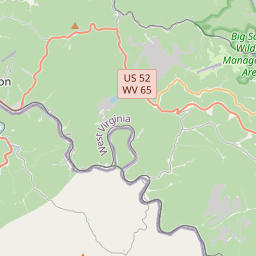The Battle of Matewan
Historical marker location:
Matewan, West Virginia
( Marker is at the intersection of Ferrell Street and Hatfield Street, on the right when traveling north on Ferrell Street.)







© OpenStreetMap contributors
National Coal Heritage Trail
The West Virginia State Penitentiary in Moundsville, West Virginia, operated from 1866 to 1995, and was known for its harsh conditions and numerous executions. The prison is now a tourist attraction and offers tours of the facility.
About Mingo County
Mingo County Timeline
Mingo County, West Virginia, has a rich and complex history that dates back centuries. The area was originally home to Native American tribes, including the Shawnee and Delaware, who inhabited the region for thousands of years prior to European settlement. The county was named after the Mingo tribe, and their presence is still felt through the numerous landmarks and cultural traditions that exist in the area today.
European settlers began arriving in the 18th century, with the establishment of forts and settlements along the Ohio River. The coal industry played a significant role in shaping Mingo County's history, as large deposits of coal were discovered in the late 19th century. This led to an influx of immigrants, mainly from Central and Eastern Europe, who sought work in the mines. The coal industry boomed during this time, and coal became a major economic driver for the county.
However, the coal industry also brought about various challenges, including labor disputes and working conditions. Mingo County became a hotspot for labor struggles, with the Battle of Blair Mountain in 1921 being one of the largest armed uprisings in United States history. It was a turning point for labor rights in the country and brought national attention to the struggles faced by coal miners.
In recent years, Mingo County has faced economic challenges due to the decline of the coal industry. Efforts are being made to diversify the local economy, particularly in the areas of tourism and outdoor recreation. Despite the hardships, Mingo County remains a resilient community with a deep-rooted history and a strong sense of pride in its Appalachian heritage.
European settlers began arriving in the 18th century, with the establishment of forts and settlements along the Ohio River. The coal industry played a significant role in shaping Mingo County's history, as large deposits of coal were discovered in the late 19th century. This led to an influx of immigrants, mainly from Central and Eastern Europe, who sought work in the mines. The coal industry boomed during this time, and coal became a major economic driver for the county.
However, the coal industry also brought about various challenges, including labor disputes and working conditions. Mingo County became a hotspot for labor struggles, with the Battle of Blair Mountain in 1921 being one of the largest armed uprisings in United States history. It was a turning point for labor rights in the country and brought national attention to the struggles faced by coal miners.
In recent years, Mingo County has faced economic challenges due to the decline of the coal industry. Efforts are being made to diversify the local economy, particularly in the areas of tourism and outdoor recreation. Despite the hardships, Mingo County remains a resilient community with a deep-rooted history and a strong sense of pride in its Appalachian heritage.
Mingo County Timeline
This timeline provides a glimpse into the major events and milestones that have shaped the history of Mingo County, West Virginia.
- 1777 - Mingo County is organized as part of Virginia
- 1863 - The area becomes part of West Virginia during the Civil War
- 1870 - The Hatfield-McCoy feud, a famous family feud, begins in the county
- 1895 - The county is officially established and named after the Mingo Indian tribe
- 1907 - The Mannington Coal Mine disaster claims the lives of 78 miners
- 1947 - The Buffalo Creek flood kills over 125 people and leaves thousands homeless
- 1983 - The last operating coal mine in the county closes